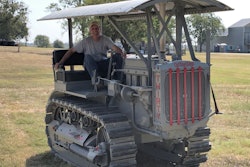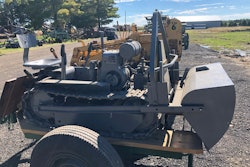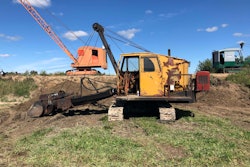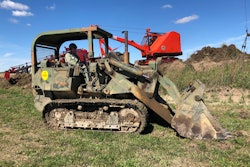The online forum for the antique Caterpillar collectors’ community was all abuzz in December 2013. Two photos had just been posted by a hiker showing a rusted old crawler tractor in the hills of Simi Valley, California.
It was a 1919 Best 25 Tracklayer – the smallest tractor built by the C.L. Best Tractor Company and very rare. Only 300 were ever made by the company, which later merged with the Holt Manufacturing Company to form the Caterpillar Tractor Company in 1925. Most are gone today, with probably less than a dozen still remaining, and only five or so in working condition.
The race was on among diehard collectors of the Antique Caterpillar Machinery Owners Club.
After a search that included matching the terrain on Google Earth, hiking uphill with backpacks filled with tools and hiring a Vietnam-era helicopter, Matt Veerkamp beat out the others and claimed the rare Best.
“I had competition,” he says. “Any Best and Holt machine is definitely sought after. They're worth more. They're more rare. They're hard to get. And then there are a few models like the Best 25 that are extremely rare, that you just don't have a lot of chances to be able to get them.”
Best on Google Earth
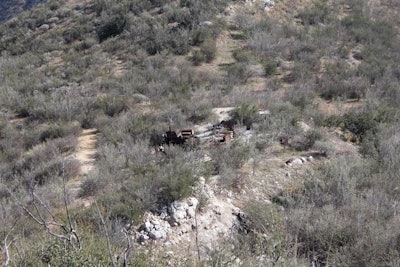 A hiker posted a photo to the Antique Caterpillar Machinery Owners Club's website, setting off a race to find the rare 1919 Best 25.Matt Veerkamp and Shawn Stover
A hiker posted a photo to the Antique Caterpillar Machinery Owners Club's website, setting off a race to find the rare 1919 Best 25.Matt Veerkamp and Shawn Stover
With permission to remove the old tractor – which the conservancy considered to be a nuisance – Veerkamp made plans to get it. Because of the terrain with all roads washed out, he couldn’t haul it out by land, so he hired a helicopter to bring it down. He and coworker and fellow collector Shawn Stover borrowed some backpacks, filled them with 60 pounds of tools each and hiked to the spot. They parked the truck and trailer as close as they could, about 1,100 feet down a steep hill from the tractor.
As he climbed upward, Veerkamp was excited but also nervous.
“I just had this fear that we’d get up there and it'd be gone, or it wasn't what we thought it was, because I'd only seen pictures. We set all this up based on two pictures.”
But the fear soon evaporated at seeing the 95-year-old Best 25 sitting as it had since the 1940s-1950s.
“It was real,” he says. “It was true.”
Best in the Air
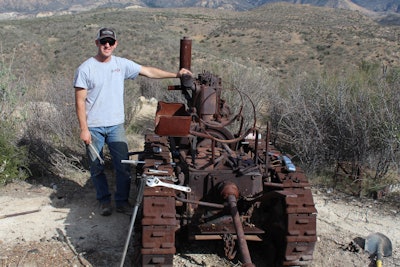 Matt Veerkamp, above, and Shawn Stover found the Best 25 and took it apart so it could be airlifted off its hill in Simi Valley.Matt Veerkamp and Shawn Stover
Matt Veerkamp, above, and Shawn Stover found the Best 25 and took it apart so it could be airlifted off its hill in Simi Valley.Matt Veerkamp and Shawn Stover
It could only lift 4,000 pounds at a time. The Best 25 weighed about 5,200 pounds. So Veerkamp and Stover had to take the tractor apart before it could be lifted. After about four hours, they had separated out the 25-horsepower gasoline engine from the chassis. The engine would go down first, then the chassis.
“Surprisingly enough, things weren't welded together,” Veerkamp says. “It was rusty, but nothing was tight. The tracks would roll. All the bolts came off. It was really strange to me.”
Veerkamp cleared an area for the helicopter to land and painted a large letter “H.”
“He landed right there, really close to the tractor, and then we made a rigging plan and went to work.”
The airlift was seamless. The engine and then the chassis were gingerly placed on the trailer in minutes.
“He put it on the trailer,” Veerkamp says of the pilot. “We tied it down, and we were gone. It was the easiest thing.”
Rebuilt from the Ground Up
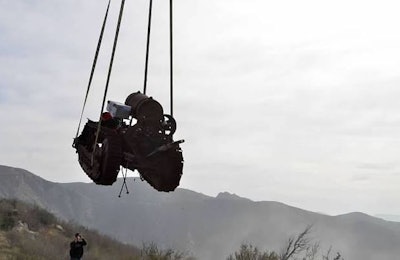 The Best 25 chassis gets a lift.Matt Veerkamp and Shawn Stover
The Best 25 chassis gets a lift.Matt Veerkamp and Shawn Stover
A lot of parts were missing, having been taken and sold for scrap by scavengers. The fuel tank and all the tin were gone. The radiator, which had copper in it, the brass carburetor and magnetos, the manifolds, the throttle – all missing.
“We had to remake mostly all of it from scratch,” Veerkamp says. “Anything you could easily take off and get some money for it, it was robbed.”
So the tractor was completely taken apart, down to every nut and bolt, and rebuilt from the ground up.
Many of the parts had to made. They would make wooden models of the parts and have them cast. They 3D-printed the manifold.
One thing in their favor was the undercarriage’s good shape. The tractor had been used by the mining company to power a crusher, so it had stayed in one place.
Back Doing What it Does Best
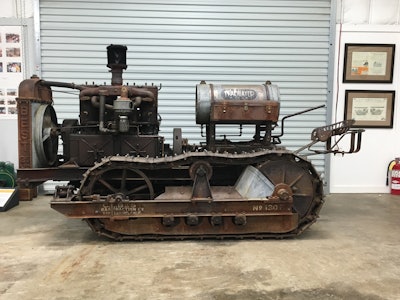 The Best 25 is restored and ready to run and is on display at the Veerkamps' museum in Placerville, California.Matt Veerkamp and Shawn Stover
The Best 25 is restored and ready to run and is on display at the Veerkamps' museum in Placerville, California.Matt Veerkamp and Shawn Stover
A rod is used to spin the flywheel to start the 4-cylinder motor. The engine begins to pop and rumble as it starts.
“Just hearing it run and drive for the first time was just the most amazing feeling,” Veerkamp says.
“Mechanically it's brand new,” he adds. “It just looks like it's old.” That’s because he wanted it to look the way it did when they found it, preferring to keep its patina rather than a bright, shiny restored look.
“I wanted to keep it in its work clothes,” he explains. “Because it took 100 years for it to appear that way, I really didn't want to change that.”
Best in Show
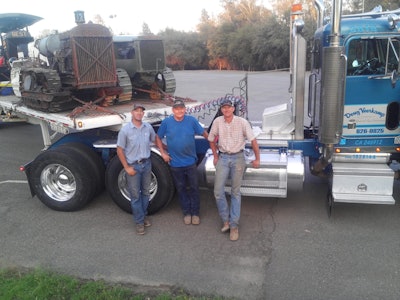 The 1919 Best 25 Tracklayer often travels to antique equipment shows. From left, Matt Veerkamp, Jim Campbell and Shawn Stover.Matt Veerkamp and Shawn Stover
The 1919 Best 25 Tracklayer often travels to antique equipment shows. From left, Matt Veerkamp, Jim Campbell and Shawn Stover.Matt Veerkamp and Shawn Stover
Matt Veerkamp ranks the Best 25 as his favorite find and among the top three in rarity. It also has special meaning in that family friend Jim Chapman, who restored it, has since passed away.
It’s one of the pieces the Veerkamps always take to shows, and it draws a crowd.
“We’ve got hundreds of tractors, and I say this one is one of the eyecatchers that people just go to,” Matt Veerkamp says. “They don't even know the story, but they go to it just because of how small it is and how neat it looks.”
Veerkamp has no plans to ever sell it. It’s still worth more than all the difficulty and cost of rescuing and restoring it.
“It's such a special tractor, very rare, that we definitely went to the lengths,” he says.
“And I’m not going to lie, it was really fun.”





